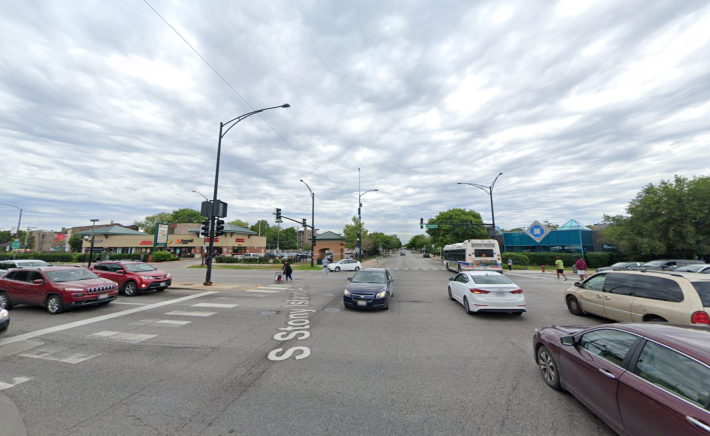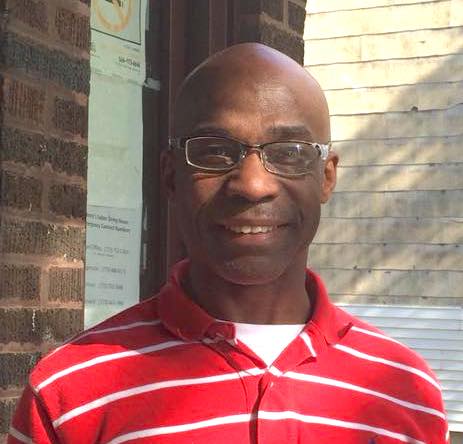After an unlicensed, uninsured driver fatally struck Lee Luellen, 40, on his bike at early Sunday morning in Grand Crossing, police initially implied that Luellen might have been responsible for his own death, stating that he "may have been in the middle of the street when he was hit." The Chicago Police Department has since walked back that statement, acknowledging that the cyclist's lane position had nothing to do with the motorist killing him.
And although Luellen was the second cyclist killed on this stretch of Stony Island Avenue in less than a year and a half, local alderman Leslie Hairston has doubled down on her resistance to the Chicago Department of Transportation's proposal to install protected bike lanes on the roadway.
According to police, on Sunday November 17, Luellen was cycling west on 67th Street crossing Stony Island, which is eight lanes wide at this location, which encourages speeding by drivers. The northbound driver of of a gray Chevrolet Impala, later identified as Sabrinia Williams, 42, struck him.

Luellen, of the 3800 block of West Monroe Street, was transported to Jackson Park Hospital and later was pronounced dead, according to the Cook County medical examiner's office.
According to Police News Affairs, Williams was charged with three misdemeanors, including driving on a suspended license, driving an uninsured vehicle in a crash that resulted in bodily harm, and failure to reduce speed to avoid a crash. She has a court date on December 5.
Soon after the crash, police said Luellen might have been riding "in the middle of the street" when he was struck. When I asked News Affairs what was meant by that, I was told, "according to the crash report diagram, the bicyclist crossed the street in the middle of the lane, not in a crosswalk." Of course, cyclists aren't supposed to cross streets in crosswalks, but rather they're supposed to use a travel lane, either riding to the right of motorized traffic, or else in the center of the lane, aka "taking the lane," which is a legal practice.
CPD spokesman Steve Rusanov later told the Chicago Tribune that investigators aren’t sure where on 67th Luellen was riding, but acknowledged that has no bearing in determining who was to blame for the crash. “The driver of the vehicle that hit the cyclist — regardless if (Luellen) was in the center of the street, the side of the street — as far as tickets and citations go, she is the unit at fault,” he said. “The driver is at fault.”

A few years ago the Chicago Department of Transportation proposed converting a lane or two of Stony Island between 67th and 79th into protected bike lanes. The plan was opposed by 5th Ward Alderman Leslie Hairston and 8th Ward alderman Michelle Harris on the grounds that it would cause traffic congestion.
At the time, Hairston claimed the eight-lane street carried 60,000 vehicles a day, although that number was actually 35,000. Studies show that streets with two travel lanes plus a turn lane can handle up to 20,000 daily trips without congestion problems, which suggests converting one or two lanes on Stony wouldn't cause carmageddon.
South Shore resident and bike advocate Elihu Blanks said Harris privately told him that him didn't support the bike lane project because she believed there was no demand for it, saying, "We don't bike on this side of town."
In July 2018, Luster Jackson, 58, was killed on his bike on Stony Island five blocks south of the Luellen crash site, after he dodged a car door opened in his path by a driver, and was then struck by another motorist. It's nearly impossible for cyclists to get doored in most Chicago-style protected bike lanes, which are generally located next to the curb with a wide striped buffer or curb between the bike lane and parked cars.

Even after this latest death on Stony Island, Hairston hasn't seen the light. She told Block Club Chicago that the protected lanes “would not have made a difference” in preventing Luellen’s “tragic accident,” indicating that she still doesn't support installing bike lanes on the avenue. ("Tragic accident" is a phrase city officials and police often use in the wake of bike and pedestrian fatalities that implies there was no way the driver could have avoided killing the vulnerable road user -- see also the recent deaths of pedestrian Elizabeth Boshardy and cyclist Carla Aiello.)
In reality, converting a lane or two of Stony Island to protected bike lanes, aka a "road diet," would have narrowed the amount of available space for drivers, encouraging legal speeds. That might have made a difference in Luellen's case, since the driver who killed him was charged with failure to reduce speed, which indicates she may have been speeding.
Yesterday at an event marking World Day of Remembrance for Road Traffic Victims, CDOT acting commissioner Tom Carney indicated that, despite the fact that Mayor Lori Lightfoot signed an executive order supposedly ending aldermanic prerogative earlier this year, the department will still allow bike-hostile aldermen like Hairston and and Harris to veto bikeway projects in their wards.
Therefore, it looks like it will be necessary for citizens to apply some political pressure on city officials in order to get CDOT to follow through with its Stony Island bike lane plan. That would help prevent still more senseless loss of life on the avenue.
Fatality Tracker: 2019 Chicago pedestrian and bicyclist deaths on surface streets
Pedestrian: 35
Bicyclist: 4
Note: Streetsblog Chicago’s traffic death numbers represent fatal crashes on Chicago surface streets, based on preliminary Chicago Police Department data for January though August 2019 released by the Chicago Department of Transportation, plus media reports for September, October, and November.




